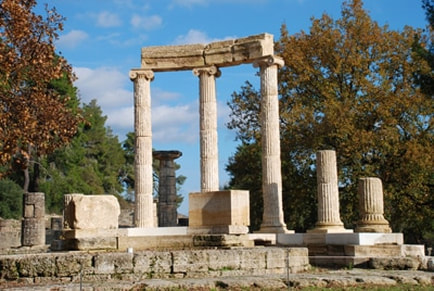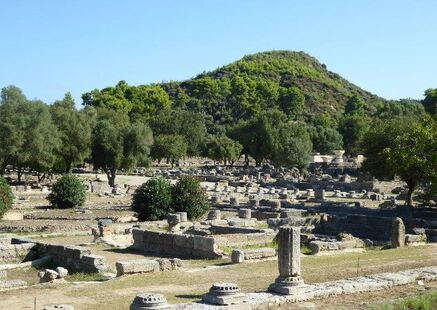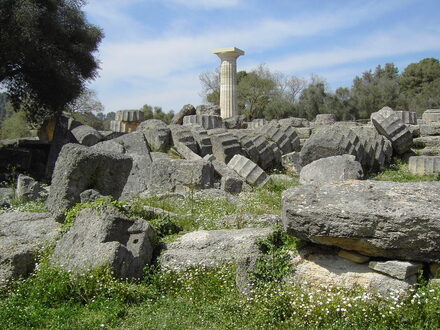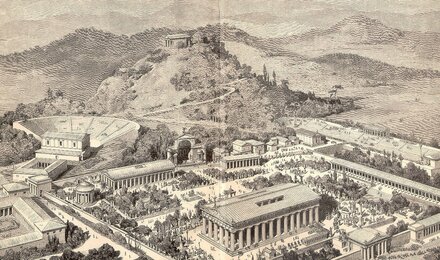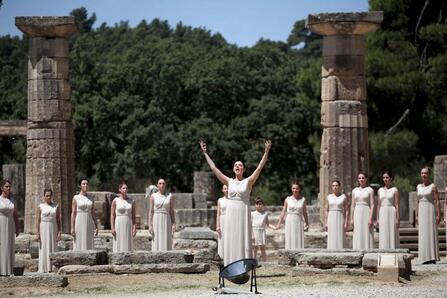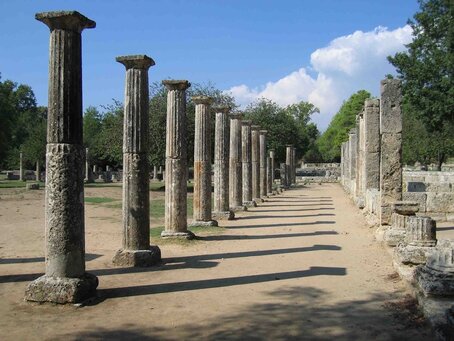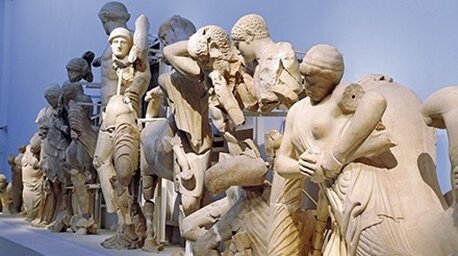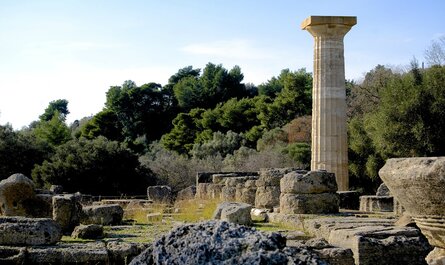Olympia
|
 | 8 Days Winter in Greece Classical Greece from Athens $1,190.18 Discover the famous historical monuments |
Not far from Olympia, beachfront located by the Ionian Sea in Navarino Dunes area of Costa Navarino, the prime sustainable destination in the Mediterranean, The Westin Resort Costa Navarino offers limitless opportunities to energize, relax and transform. Being praised as top in Greece with Condé Nast Traveller’s 2022 Readers’ Choice Award in “The best resorts in the world”, the property is a unique escape for families with countless ways to explore and play; two innovative kids’ clubs, the one-of-a-kind Division 16 youth hub, an impressive Aqua Park, refreshing pools and the endless beach, combine with a wide variety of sports and activities including four signature golf courses, a new Tennis Center, on- and under-water sports, outdoor pursuits to the breath-taking nature and more. Savor nourishing menus and locally sourced dishes in a stunning variety of venues, unwind at the Anazoe Spa with its natural, therapeutic treatments, or discover the region’s culture through a series of authentic experiences.
W Costa Navarino marks the debut of the W Hotels brand in Greece. The new Escape, exclusively for adults and young adults over 12 years old, opened in August 2022 to bring contemporary design and inspiring energy to the Navarino Waterfront 13-hectare beachfront site by the Ionian Sea, the newest integrated area of Costa Navarino. Vivid and bright, with a distinctive design inspired by the region’s architecture with natural materials like stone, wood, and reed, W Costa Navarino shows stylish accommodations with swim-up rooms, airy one and two-bedroom suites with their own pools, and fantastic beachfront villas with their private pools set against the stunning Ionian sunset. Playful public spaces, three dining venues, including a vibrant Beach Club, a wellness area with AWAY® Spa and FIT gym to fuel body and mind, together with inventive yet authentic cuisine and welcoming service, create a socially driven destination any time of the day.
W Costa Navarino marks the debut of the W Hotels brand in Greece. The new Escape, exclusively for adults and young adults over 12 years old, opened in August 2022 to bring contemporary design and inspiring energy to the Navarino Waterfront 13-hectare beachfront site by the Ionian Sea, the newest integrated area of Costa Navarino. Vivid and bright, with a distinctive design inspired by the region’s architecture with natural materials like stone, wood, and reed, W Costa Navarino shows stylish accommodations with swim-up rooms, airy one and two-bedroom suites with their own pools, and fantastic beachfront villas with their private pools set against the stunning Ionian sunset. Playful public spaces, three dining venues, including a vibrant Beach Club, a wellness area with AWAY® Spa and FIT gym to fuel body and mind, together with inventive yet authentic cuisine and welcoming service, create a socially driven destination any time of the day.
The archaeological site of Olympia includes the sanctuary of Zeus and the many buildings erected around it, such as athletic premises used for the preparation and celebration of the Olympic Games, administrative buildings and other lay buildings and monuments. The Altis, the sacred enclosure and core of the sanctuary, with its temples, cult buildings and treasuries, occupies the center of the site. It is surrounded by a peribolos, or enclosure wall, which in the late 4th c. BC had three gates on its west side and two on the south, and is bordered on the east by the Echo Stoa, which separates the sacred precinct from the stadium. The enclosure wall was extended in Roman times and two monumental entrances were created on its west side.
The Classical Temple of Zeus and the earlier Temple of Hera dominate the Altis. East of the Heraion is the Metroon, a temple dedicated to Cybele, the mother of the gods, and behind this, on the foot of Mt. Kronios, a row of treasuries dedicated by Greek cities and colonies. To their west lies the Nymphaion, a splendid fountain dedicated by Herodes Atticus. South of the Heraion and over the remains of the prehistoric settlement of Olympia is the Pelopion, a funerary monument commemorating the hero Pelops. Also within the Altis are the Prytaneion, the seat of the sanctuary officials, and the Philippeion, an elegant circular building dedicated by Philip II, king of Macedon. Southeast of the Heraion was the great altar of Zeus, a most important monument entirely made of ashes and therefore now completely lost. The remaining space inside the Altis was filled with numerous altars and statues of gods, heroes and Olympic winners dedicated by Greek cities or wealthy individuals, such as the Nike of Paionios. Outside the sacred precinct of the Altis, to its south, are the Bouleutherion and the South Stoa, the southernmost building of the greater sanctuary and its main entrance from the south. West of the Altis, and separated from it by the Sacred Road, is a series of buildings for the sanctuary personnel, the athletes and the distinguished visitors: the gymnasium and palaestra, exercise grounds, the Workshop of Pheidias which in Late Antiquity was transformed into a Christian church, the Greek baths with their swimming pool, the Roman Baths, the Theokoleion or priests' residence, the Leonidaion or officials' quarters, and the Roman hostels. East of the Altis lies the stadium where the Olympic Games were held. South of the stadium was the hippodrome, of which no trace remains as it was swept away by the Alpheios river. South of the hippodrome is a group of mansions and baths, including the famous House of Nero, built by the emperor for his stay at Olympia during his participation in the games.
History of the (ancient) Olympic Games Museum
Children’s activities and tours are heavily supported in this very interesting museum. Apart from the interactive applications and games for children about the ancient Olympic Games and the sports, all visitors can enjoy virtual tours to the ancient Olympic Games. Furthermore, visitors can view a collection of terracotta artefacts, a collection of bronzes, a collection of sculptures (Archaic up to the Roman periods), and most of all a great collection from the ancient Olympic Games.
Children’s activities and tours are heavily supported in this very interesting museum. Apart from the interactive applications and games for children about the ancient Olympic Games and the sports, all visitors can enjoy virtual tours to the ancient Olympic Games. Furthermore, visitors can view a collection of terracotta artefacts, a collection of bronzes, a collection of sculptures (Archaic up to the Roman periods), and most of all a great collection from the ancient Olympic Games.
Museum of the Modern Olympic Games
This small museum off of the main street in Olympia city, hosts a bunch of artifacts from the modern Olympics, including the silk-lined box in which they transported Pierre de Coubertin's (1863-1937), the French father of the reborn modern Olympic Games, heart to be buried in Olympia in 1939. Lots of photos and documents from the revival period and a nice summary of each host city for all summer and some of winter games.
This small museum off of the main street in Olympia city, hosts a bunch of artifacts from the modern Olympics, including the silk-lined box in which they transported Pierre de Coubertin's (1863-1937), the French father of the reborn modern Olympic Games, heart to be buried in Olympia in 1939. Lots of photos and documents from the revival period and a nice summary of each host city for all summer and some of winter games.
Archaeological Museum of Olympia
Within a few minutes walk from the archaeological site lies the Archaeological Museum, It was founded in the 19th c. to house the finds that the excavations in Olympia constantly brought to light. However, as a growing wealth of artifacts kept accumulating, even after a century-long archaeological research, and due to the high seismic activity in the area, it became apparent that the elegant 19th c. building would not suffice. The new museum of Olympia was completed in 1975 and since then it underwent a major reorganization of its exhibition areas in 2004, in view of the Olympic Games held in Athens. Today, the museum's permanent collections cross 12 halls and over 3,500 years of history, from around the 3rd millennium BC when humans first settled in Olympia to the twilight of Zeus' sanctuary in the 7th c. AD. Renowned for its sculptures and for its collection of ancient Greek bronzes, which is the richest in the world, the Archaeological Museum of Olympia is an important Greek museum.
Within a few minutes walk from the archaeological site lies the Archaeological Museum, It was founded in the 19th c. to house the finds that the excavations in Olympia constantly brought to light. However, as a growing wealth of artifacts kept accumulating, even after a century-long archaeological research, and due to the high seismic activity in the area, it became apparent that the elegant 19th c. building would not suffice. The new museum of Olympia was completed in 1975 and since then it underwent a major reorganization of its exhibition areas in 2004, in view of the Olympic Games held in Athens. Today, the museum's permanent collections cross 12 halls and over 3,500 years of history, from around the 3rd millennium BC when humans first settled in Olympia to the twilight of Zeus' sanctuary in the 7th c. AD. Renowned for its sculptures and for its collection of ancient Greek bronzes, which is the richest in the world, the Archaeological Museum of Olympia is an important Greek museum.

